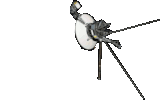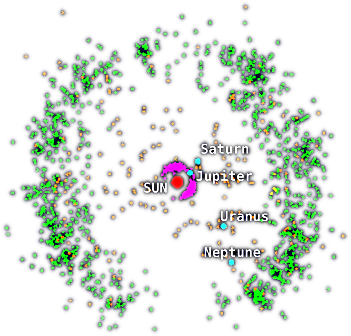
1.
Our Sun2.
Mercury Venus Our Moon Mars3.
Asteroid Belt4.
Jupiter Saturn Uranus Neptune5.
Pluto
6.
Comets
The Kuiper belt is a circumstellar disc in the outer Solar System, extending from the orbit of Neptune (at 30 AU) to approximately 50 AU from the Sun. It is similar to the asteroid belt, but is far larger (20 times as wide and 20 to 200 times as massive).
Like the asteroid belt, it consists mainly of small bodies or remnants from when the Solar System formed. While many asteroids are composed primarily of rock and metal, most Kuiper belt objects are composed largely of frozen volatiles (termed "ices"), such as methane, ammonia and water.
The Kuiper belt was named after Dutch-American astronomer Gerard Kuiper, though he did not predict its existence. In 1992, Albion was discovered, the first Kuiper belt object (KBO) since Pluto and Charon. Since then the number of known KBOs has increased to thousands, and more than 100,000 KBOs over 100 km in diameter are thought to exist.
The Kuiper belt is home to three officially recognized dwarf planets: Pluto, Haumea and Makemake.
The Kuiper belt is distinct from the theoretical Oort cloud, which is a thousand times more distant and is mostly spherical. The objects within the Kuiper belt, together with the members of the scattered disc and any potential Hills cloud or Oort cloud objects, are collectively referred to as trans-Neptunian objects (TNOs).
The Kuiper belt and Neptune may be treated as a marker of the extent of the Solar System.
Reference: Wikipedia - Kuiper belt

Pluto (minor planet designation: 134340 Pluto) is an icy dwarf planet in the Kuiper belt, a ring of bodies beyond the orbit of Neptune. It was the first and the largest Kuiper belt object to be discovered.
Pluto was discovered by Clyde Tombaugh in 1930 and declared to be the ninth planet from the Sun. After 1992, its status as a planet was questioned following the discovery of several objects of similar size in the Kuiper belt. In 2005, Eris, a dwarf planet in the scattered disc which is 27% more massive than Pluto, was discovered. This led the International Astronomical Union (IAU) to define the term "planet" which excluded Pluto.
Pluto is primarily made of ice and rock and is relatively small at one-sixth the mass of the Moon and one-third its volume. It has a moderately eccentric and inclined orbit during which it ranges from 30 to 49 astronomical units or AU from the Sun.
Light from the Sun takes 5.5 hours to reach Pluto at its average distance.
Pluto has five known moons: Charon (the largest, with a diameter just over half that of Pluto), Styx, Nix, Kerberos, and Hydra. Pluto and Charon are sometimes considered a binary system because the barycenter of their orbits does not lie within either body.
The New Horizons spacecraft performed a flyby of Pluto on July 14, 2015, becoming the first ever, and to date only, spacecraft to do so. During its brief flyby, New Horizons made detailed measurements and observations of Pluto and its moons.
In September 2016, astronomers announced that the reddish-brown cap of the north pole of Charon is composed of tholins, organic macromolecules that may be ingredients for the emergence of life, and produced from methane, nitrogen and other gases released from the atmosphere of Pluto and transferred 19,000 km (12,000 mi) to the orbiting moon.
Reference: Wikipedia - Pluto
A spacecraft mission
to explore our Solar System starts with its launch from earth using a rocket launcher. The spacecraft then uses its own engines to reach its objective and carry out its mission. Some missions have multiple objectives.
The duration of a mission varies, depending on the craft used and purpose of the mission.
The table below is an overview or all the successful spacecraft missions, to date, used to study dwarf planet Pluto. It only includes spacecraft that left Earth orbit to perform their mission.
Point to ℹ for table information. (Table head remains visible while scrolling)
Select the Spacecraft name or Target for more information.
| Img | Spacecraft | Launcher | Country | Year | Target | Notes | |
| Launch | End | ||||||
| 1 | New Horizons | Atlas V (551) Star 48B 3rd stage |
U.S. | 2006 | - | Pluto, Asteroid 132524 APL, 486958 Arrokoth |
Part of NASA's New Frontiers program. Its primary mission to perform a flyby study of the Pluto system in 2015, and a secondary mission to fly by and study one or more other Kuiper belt objects. It is the fifth space probe to achieve the escape velocity needed to leave the Solar System. |
This gallery contains images of spacecraft and their launch vehicles (rockets) used on the above missions. (Numbers relate to the table above)
Thumbnails: Click on a thumbnail image to enlarge it. | Enlarged image: Click on right side of image for next image or on left side for previous image. Click outside image to close.